
A brand guide is a tool that businesses, groups, or even individuals can use to ensure that they present a clear, consistent image to the world. In this post, we’ll look at why brand guides are so powerful and how creating your own can improve the look, sound, feel, and success of your organization.
What Is a Brand Guide?
A brand guide is a document that defines an organization’s visual identity and character. It includes descriptions and guidelines that explain how a brand should present itself.
A brand guide is sometimes referred to as a:
- Style Guide
- Brand Bibles
- Visual Brand Identity
- Visual Style Guide
- Corporate Identity
A complete brand guide includes elements from each of these types of guides. It outlines the entire public image of an organization — from the way they display their branded graphics to the tone they use in their advertisements to the spacing on their outdoor signage.
A brand guide is an important document that says who an organization is and how they share that identity with the world, and it’s a valuable guide for groups ranging from big brands to small organizations.
What’s the Value In Having a Brand Guide?
Brand guides are essential for any organized group because having a clear and consistent public image is valuable in a variety of ways.
- It establishes brand recognition. A cohesive image makes it easier for the public to remember and recognize a brand.
- It builds the appearance of a premium brand. Consistency in even the smallest details helps a brand present a professional appearance.
- It develops authentic brand positioning. When a brand regularly projects the same image, it appears more real and true to its values.
- It creates deeper customer loyalty. Brands with a clear core character resonate more deeply with customers and create longer lasting brand affinity.
- It simplifies company communication. Having clearly outlined guidelines gives employees a reference point and makes it easier for them to get on the same page.
- It educates third-party consultants and freelancers. A complete brand guide quickly educates third-parties hired to develop marketing, advertising, or promotional materials.
- It serves PR efforts. A public resource that includes brand assets makes it easier for media outlets to promote a brand using the appropriate logos, colors, and messaging.
Organizations that don’t have a clear brand guide often end up with a hodgepodge of marketing materials and branded media that feels disjointed. The messaging is confusing, inconsistent, and sometimes even puzzling.
On the other hand, having one complete brand guide establishes guidelines that are easy for customers to notice, vendors to replicate, media to represent accurately, and team members to adhere to.
What’s Included in a Brand Guide?
Brand guides look different for every organization. Some groups put together long, detailed guides that focus on each of the following elements. Other groups choose to focus on a few sections. The size of the organization will usually correlate to the length and depth of the brand guide. But that doesn’t mean small organizations can overlook this important document.
Creating a brand guide with the following elements will help business and groups both big and small.
Brand Mission
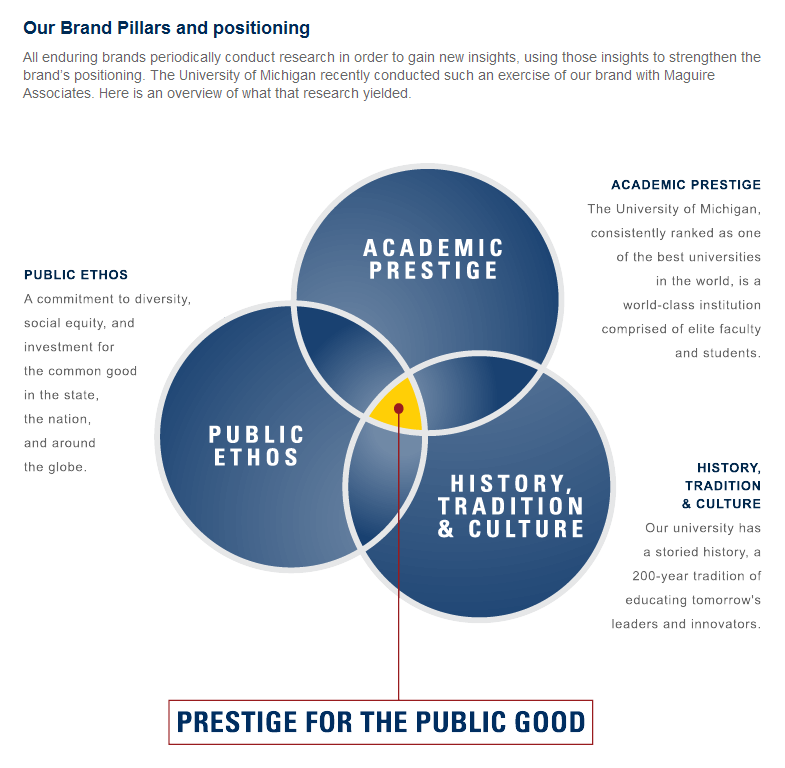 When people think about brand guides, they usually think about imagery, colors, and logos, but brand guides are more than rules related to visual images.
When people think about brand guides, they usually think about imagery, colors, and logos, but brand guides are more than rules related to visual images.
Complete guides include a brand strategy and philosophy that define both the organization’s look and core values. They identify the brand pillars, values, mission statements, and key messaging that sit at the heart of an organization and direct many of the other details of the brand guide.
The University of Michigan does a great job at defining their mission at the beginning of their brand guide. Their brand strategy starts by defining their brand pillars and positioning.
A style guide can then dig deeper into a brand’s mission and public positioning by identifying what makes them stand out.
Great brand guides include value propositions that make an organization unique and differentiators that explain why they are superior to competitors. This further defines the brand, carves out their place in the market, and shares their point-of-view.
After their explanation of their mission, The University of Michigan’s guide goes on to explain the characteristics and unique selling propositions that make up their brand. Their value proposition states that they are “a public powerhouse grounded in academic excellence and integrity that is leading meaningful change”. They then list out words that describe their brand character, such as “Intelligent”, “Driven”, and “Generous”. They also spell out a few “key differentiators” that they feel distinguish them from other universities.
Voice, Tone & Style
Brand guides define an organization’s mission and explain how to present that image to the world. The voice, tone, and style guidelines define the way they communicate their message the public (and sometimes with an internal staff as well).
This section includes direction on:
- Voice — the way your brand sounds. It may reference sentence length, word length, and the use of industry jargon.
- Tone — the sentiment of your brand statements. Your tone could be professional and terse, relaxed and funny, etc.
- Style — the consistency of your brand messages. It often includes tips on grammar and preferences on word choices, capitalization rules, number usage, abbreviations, etc. Brands often use AP Style to provide consistently without rewriting the rulebook.
MailChimp provides an extremely detailed guide on content style to their team and the public. The Mailchimp Style Guide includes directions on tone, voice, and style, as well as rules for writing specific types of content.
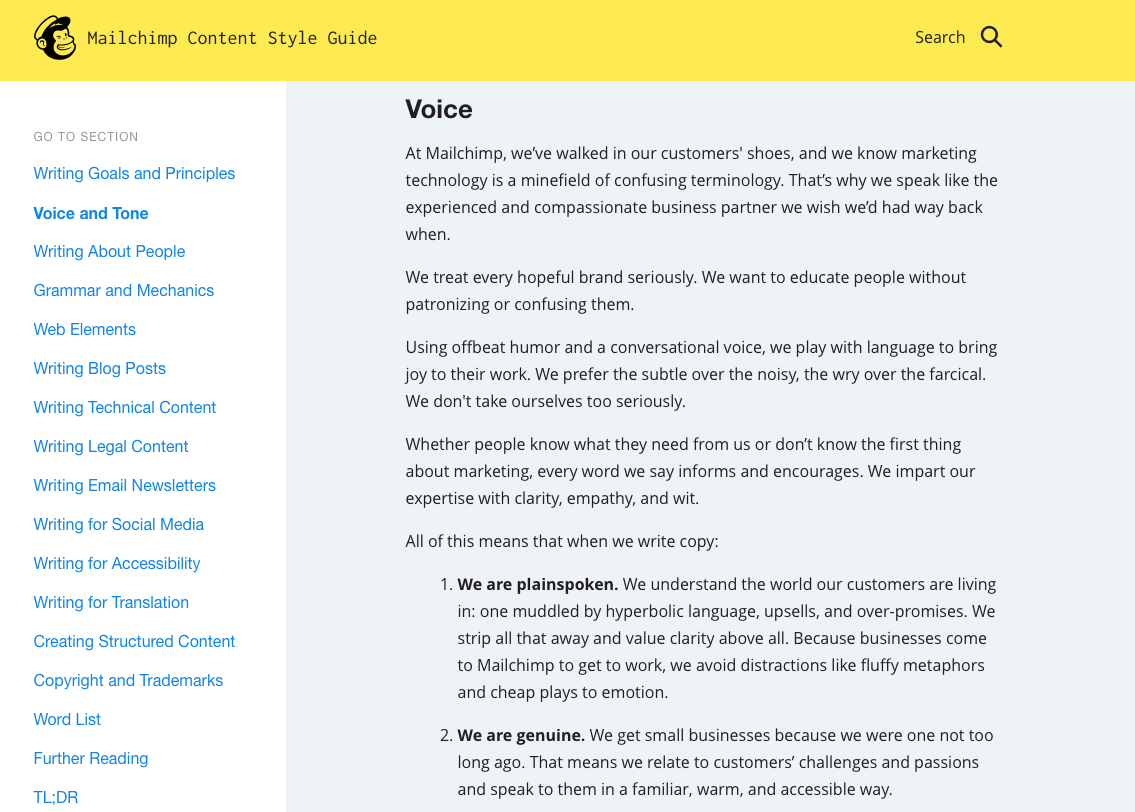
Branded Definitions & Phrases
Consistency in written communication can be further explained by defining rules specific to the organization. This may include choices on branded phrases and definitions.
These guidelines define terms and phrases and explain how they should be spelled or written such as, “The “b” in Dropbox is always lowercase and the “D” is always capitalized.” This is especially important for brands that have phrases and terms they have coined themselves, like Google, Twitter, and Pinterest.
Pinterest has words they created specifically to define their platform, tools, and user habits. In the Pinterest Brand Guidelines, they outline these terms so third-parties can properly reference definitions related to their brand. For example, they state that “Pinning” only happens on Pinterest, and that the term should not be used when referring to other social media platforms.
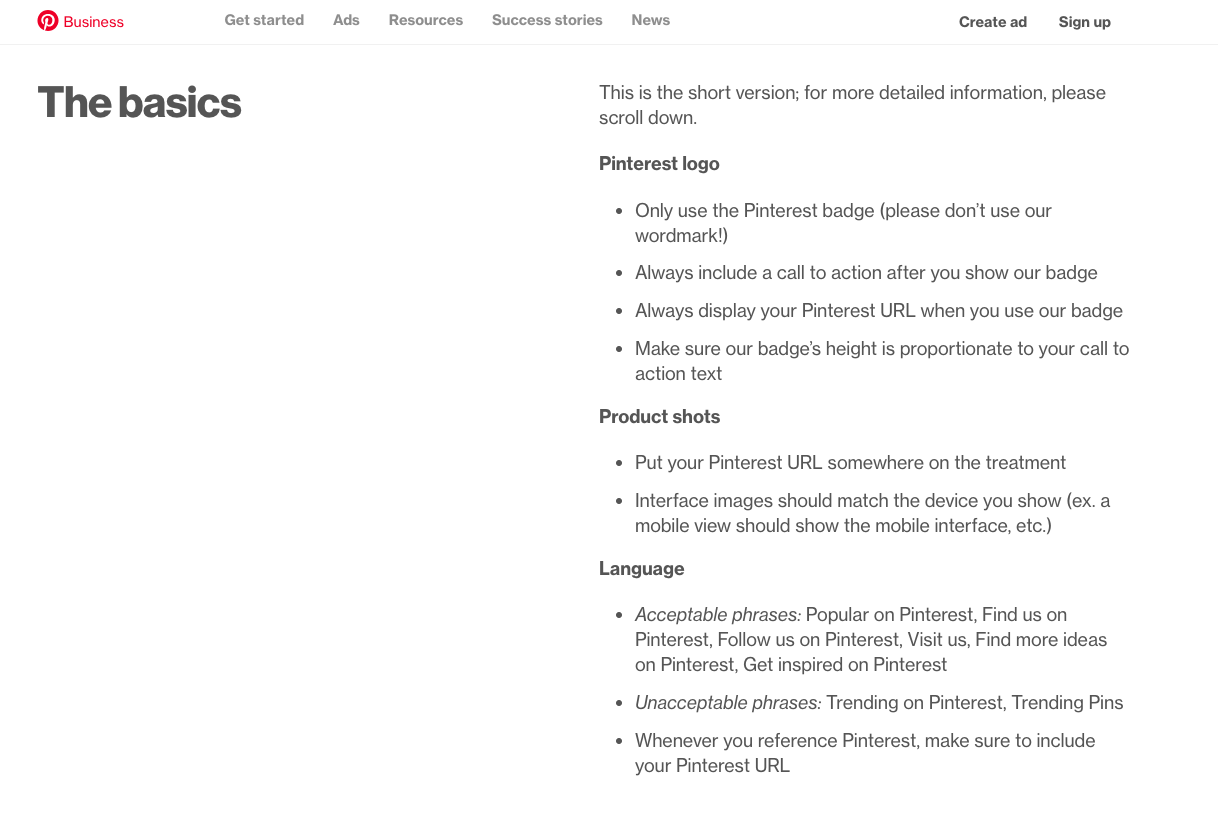
Logos
Much of a brand guide references design elements and most importantly, logos. Guides typically include details on the design of the logo, directions on how to use the logo, and tools for accessing files of the logo.
Logo details often include:
- Size and Orientation: logo specs for square, horizontal, and icon versions
- Color Variations: variations of logos with different color schemes and background colors
- Placement: spacing and usage rules
The Dropbox Brand Guide includes logo specs for multiple logos and icons. They also explain how to use logos and enable users to download official versions of their graphics.
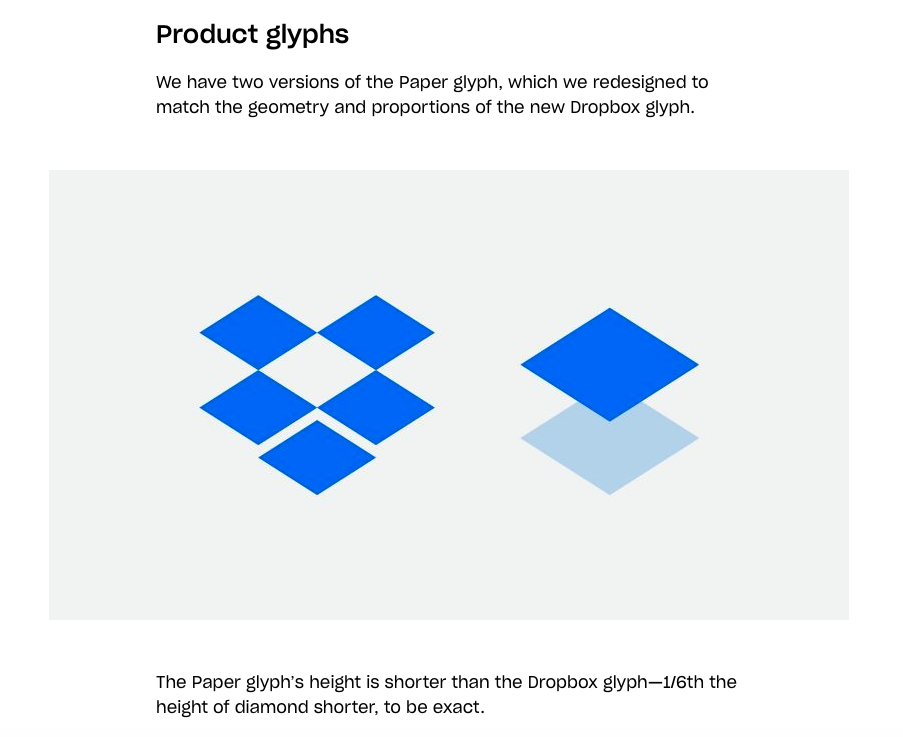
Iconography
Brands that have icons that differ from their main logo should also describe those elements in the brand guide. The guide should list all iconography associated with the brand or specific products. It should also explain how to use the icons properly and provide all versions of the icons.
The Oracle Brand Guidelines includes an iconography page that explains the concept and usage of their various icons.
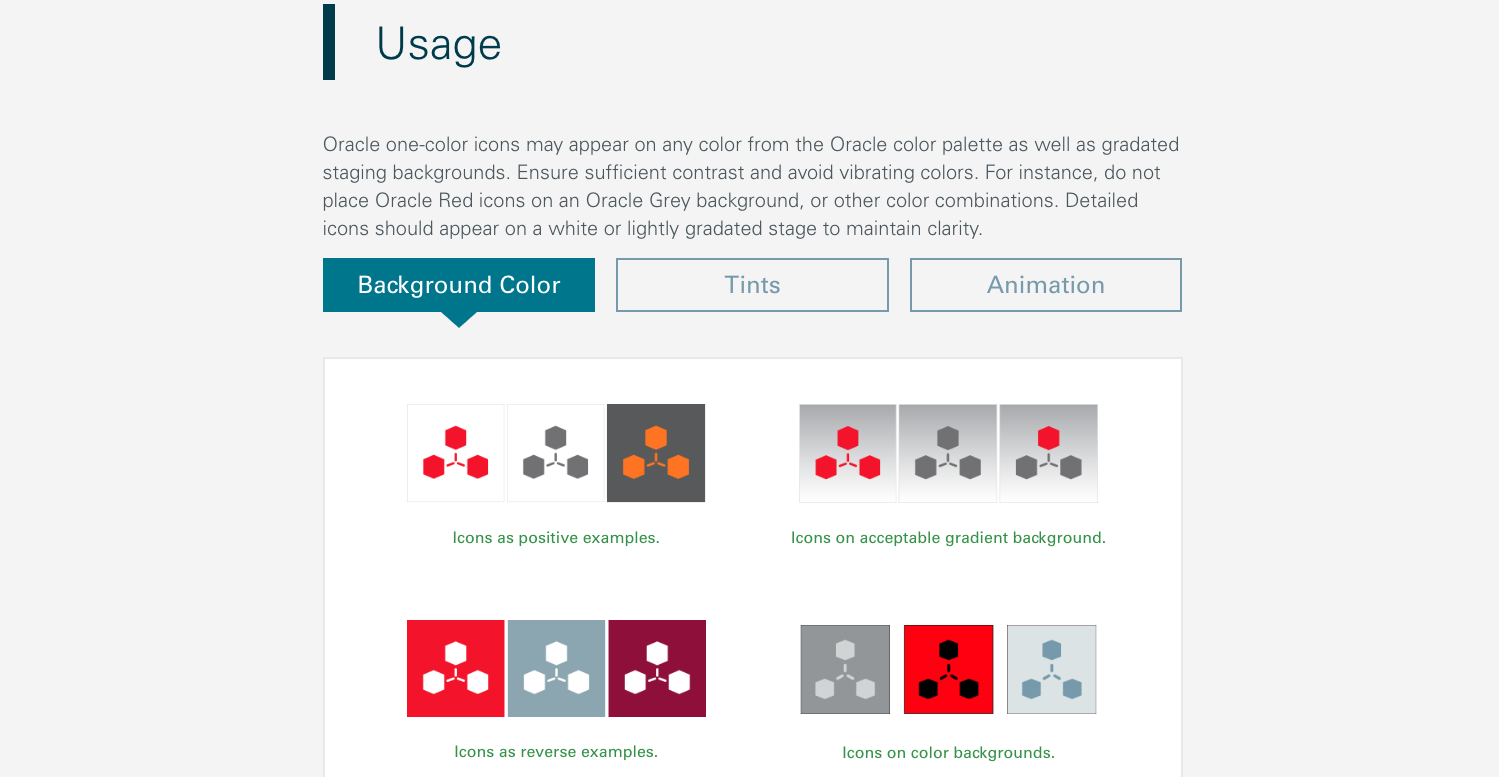
Mascots
Organizations that use mascots logos should also reference these images in their brand guide. As with the logo, a brand guide will ensure that the correct graphic is selected and properly used.
MailChimp frequently uses a monkey icon to represent their brand. The icon has changed over the years, so the Mailchimp Brand Asset Guide includes a timeline of the graphics with instructions on which to use and how to use it. Their guide advises, “Freddie is fun, but sometimes our communication is serious. If you’re using branding on a serious message, please use the MailChimp script logo.”

Colors
Color is an important branding element. But it’s not just a basic color description, like red or blue, that can define a brand’s iconic color scheme. True brand colors are defined by codes that explain what shade to use out of thousands of choices.
Colors can be identified in a variety of ways (from Hex colors for web use to Pantone colors for print). Guides should include multiple codes for the same color to ensure the exact shade is used across the board. Guides should provide information on:
- The Primary Color: the main color that represents the brand
- Secondary Color(s): the most prominent secondary colors that represent the brand
- Supporting Colors: colors that are from the same color scheme as the primary and secondary colors
The UC Berkeley Brand Guidelines dedicates a section to color. “Using color appropriately is one of the easiest ways to make sure our materials reflect a cohesive Berkeley brand.”
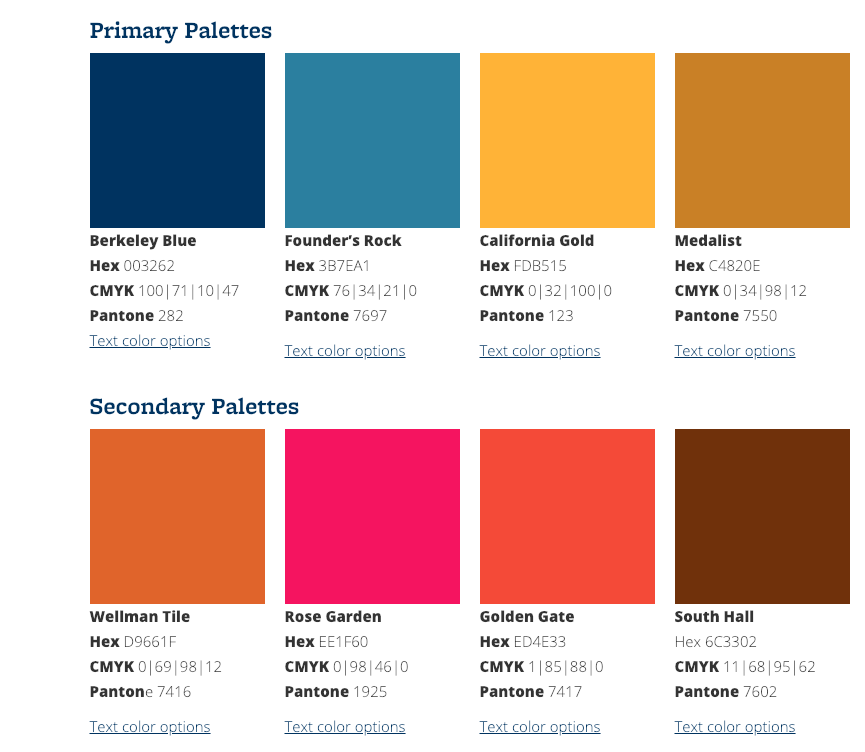
Fonts & Typography
Next to colors, fonts and typography are design elements closely connected to the brand image of an organization. So brand guides also need to have sections that explain what types of fonts to use and how to use them.
Brand guides should list the recommended font families of words in the logo (if available), the primary fonts, and the secondary fonts. These fonts might be used in print or online materials. Guides should also include rules on typography and how text should be placed on pages, so all branded materials look the same.
LinkedIn provides detailed instructions on which fonts to use and how to use them on the page. The LinkedIn Brand Guide has a long list of font and typography rules and examples.
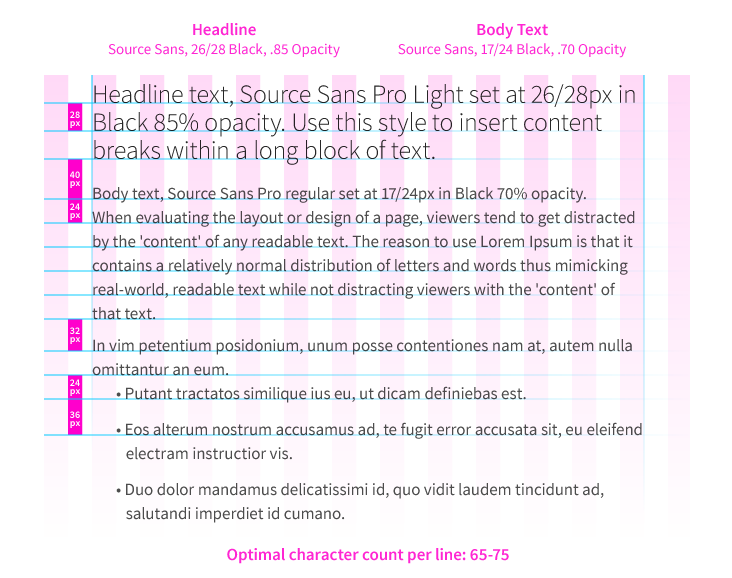
Signage Specs
Brand guides don’t just reference small design elements that go online or in brochures. They can also reference large design elements that go outdoors or on the sides of buildings, or even the design of digital signs and menu boards.
Signage specs that outline what building signage should look like may also be included in brand guides for organizations that have multiple physical locations. The specs should explain how the sign is constructed and hung.
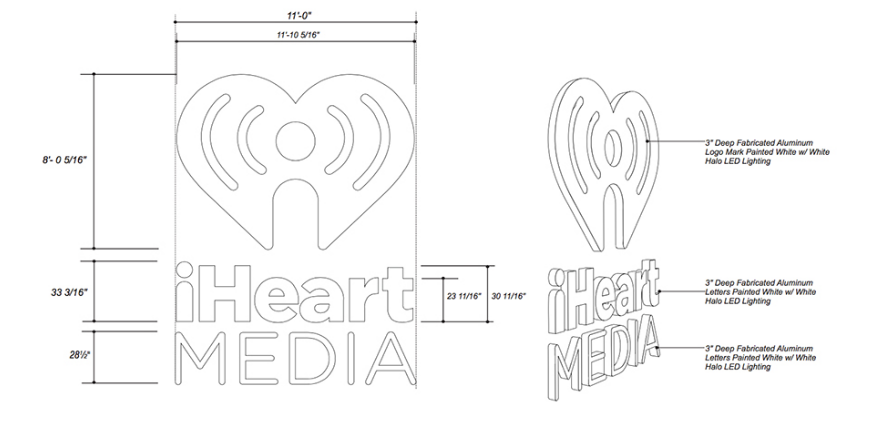
The iHeartMedia Brand Guide includes directions of the sizing of their outdoor signage as well as the construction of the materials.
Graphics, Illustrations & Photography
Brand guides define the design work that organizations create, and they also dictate the design elements they choose to incorporate into their work. Guide should include directions on how to select:
- Icons — that have a style such as simple, flat, clean, styled, outlined, etc.
- Graphics and Charts Elements — that have styles such as colors, labels, line choices, 3D, etc.
- Illustrations — that have styles such as cartoons, 3D, realistic, etc.
- Photography — that have styles realistic, abstract, tints, etc.
Knowing what type of design elements to incorporate into branded work makes the look and feel of each piece of content feel consistent.
UC Berkeley defines their design choices well with the photography directions in their Brand Guide. Knowing that they will have multiple photographs shoot images around their campus, Purdue gives a detailed description of how to take photos. This ensures that images from their campus will always look consistent even if they are captured by different photographers.

Media Formatting
Organizations have many ways to send media out into the world. A brand guide helps them make sure each piece of that content looks like it comes from the same place, no matter what platform it exists on.
Image shapes and content sizes may change based on the platform, but clear guidelines make sure each piece looks like it came from the same collection. Brand guides include directions on how to construct:
- Social Media Posts
- Blog Posts
- Press Releases
- Landing Pages
- Stationary
- Brochures
- Product Packing
- Business Cards
Details include the overall look of the image and also list the colors, fonts, and types of imagery that should be used.
The Trello Brand Guide defines how their content should look across multiple platforms. It also gives best practices about what should be included in the images and text, as well as examples that show their content consistency in action.

What Can You Do With a Brand Guide?
A brand guide brings many benefits to an organization. From building brand awareness and customer loyalty to simplifying communication efforts, style guides make it easier for a brand to present itself to the world.
With a clear style guide, organizations can create cohesive:
- Websites & Webpages
- Physical Marketing Materials
- Digital Signage Programming
- Store Environment & Atmosphere
- Overhead Music
- Staff Uniforms
- Social Media Presences
- Videos
- On-Hold Messaging
- Third-Party Media
- Advertisements & Commercials
A brand guide leads the direction and creation of both content and customer touch points. It provides a familiar feel to every piece of a brand and creates a strong visual and identity that audiences, customers, and clients can connect to.
So if you don’t have a clear brand image with a consistent look, feel, and tone, it’s time to create a brand guide that can help you identify your core messaging, design elements, and style.
Looking for even more tips on how to use smart branding and marketing efforts to promote your organization? Check out our free guide on and learn other tricks for leveraging your brand to impress customers and clients.